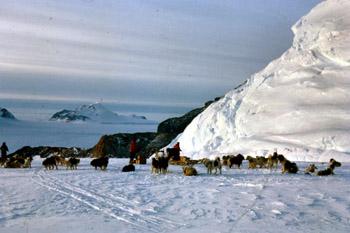In This Issue....
ISDI Launches New Partnership in Nunavik
Qimmiit Utirtut's First Litter
Update: Sledge Dog Memorial Fund
Recollections of the Doggy Man
Sledge Dogs of The Falkland Islands Dependencies Survey, 1947-50
Video Reviews:
Secrets of Antarctica
Wolf Dog
Return of the Qimutsiit
Dogs That Changed the
World
Product Review: Leather Mittens by Sterling Glove
Navigating
This Site
Index of articles by subject
Index
of back issues by volume number
Search The
Fan Hitch
Articles
to download and print
Ordering
Ken MacRury's Thesis
Our
comprehensive list of resources
Talk
to The
Fan Hitch
The Fan
Hitch home page
ISDI
home page
Editor's/Publisher's Statement
Editor: Sue Hamilton
Webmaster: Mark Hamilton
The Fan Hitch welcomes your letters, stories, comments and suggestions. The editorial staff reserves the right to edit submissions used for publication.
Contents of The Fan Hitch are protected by international copyright laws. No photo, drawing or text may be reproduced in any form without written consent. Webmasters please note: written consent is necessary before linking this site to yours! Please forward requests to Sue Hamilton, 55 Town Line Rd., Harwinton, Connecticut 06791, USA or mail@thefanhitch.org.
This site is dedicated to the Inuit Dog as well as related Inuit culture and traditions. It is also home to The Fan Hitch, Journal of the Inuit Sled Dog.

This will give you some idea of the height climbed from the sea level in the
background. The sledge loads in this picture are each about 113 Kg. (250 lb).
Each team needed about 4 relay trips to get its full 545 Kg. (1,200lb) load
to the top for the longsummer journey of 5 months. photo: G. Wright
Recollections of the Doggy Manů
I have just been talking to Hwfa with regard to our dog sledging days in the Antarctic. As you are probably aware I was the "Doggy Man" at Halley Bay during the period described in the book The Doggy Men; two years of long sledge journeys on the ice shelf and inland ice and also twice to the Shackleton Mountains (80 degrees latitude south). On these trips we covered about 3,220 kilometers (2,000 miles) with heavy survey sledges of up to 545 kilograms (1,200 pounds). Our dogs were the "Shire horses" of the sled dog breed with nine dogs averaging just over three kilometers an hour (2 mph) for approximately eight hours per day. They had learnt to right a loaded sledge, often overturned by high sastrugi, by having them pull at right angles to the sledge and slowly bringing the heavy load back on the runners.
After these trips, I was fortunate to spend a further two years and became station Commander of Stonington Island where we kept approximately 150 dogs. From Stonington we would sledge for most of the year, even through the winter. In the two years I was in charge at Stonington, we were out sledging for over 600 days. The greatest efforts I can remember were the trips from the base at sea level to the Palmer Land Plateau, a pull up of about 1,525 meters (5,000 feet) in 24 kilometers (15 miles). On the main long ice slope called "Soda Bread" and the "Cresta Run", we would relay the equipment up the steep grades.
It would take us about four days to relay the loads to the top. On more than one occasion, we had ten teams of nine or ten dogs each all linked in an up to 100-dog pull. The lead dog was attached the rear of the sledge ahead by about six meters (20 feet) of rope. The reason some dogs are looking back [in the picture below] is that it is unusual for the dogs to have this linked running style and some were curious as to the proximity of the team to the rear. The teams were tied to each other for safety reasons, due to the steepness, length and angle of the gradient and seriousness of the pull up from sea level to the polar plateau. If any individual team had peeled out, the situation would have been disastrous, with the possibility of men and dogs being hurt. The long sledge train prevented this and gave control to the senior dog driver. Upwards progress however was slow, in bursts of about three meters (10 feet).
The most exciting part of this exercise was coming down with an empty sledge. With a rope brake on the "Cow Catcher" and chains wrapped around the runners and both keels down (the keels on each runner like a yacht were to prevent the sledge turning over as you traversed across steep ice) and the foot brake hard on, the sledge still yawed about as we descended steeply. Sometimes we would clip ourselves on, and lean out on the uphill side of the sledge similar to a yacht in the wind to prevent the sledge from rolling.
This is just a flavour of my sledge days with the British Antarctic Survey. Over my time I think I must have done about 9,700 doggie kilometers (6,000 miles) in the Antarctic.
Graham Wright
(also known as Genghis or Frisby)

On the slope. The teams are combined and all pull together in short
bursts of about 3 meters (10 feet). photo: G. Wright